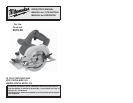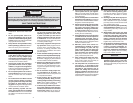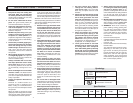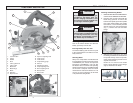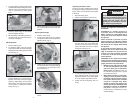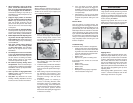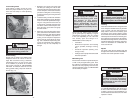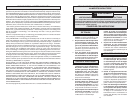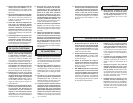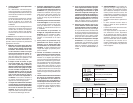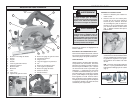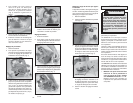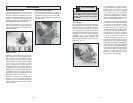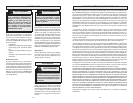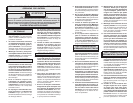
12 13
WARNING
To reduce the risk of electric shock,
check work area for hidden pipes and
wires before making pocket cuts.
Fig. 14
Fig. 13
Pocket Cutting
Pocket cuts are made in the middle of the
workpiece when it can not be cut from an
edge. We recommend using a Sawzall
®
reciprocating saw or jig saw for this type
of cut. However, if you must use a circular
saw to make a pocket cut, USE EXTREME
CAUTION. To maintain control of the saw
during pocket cutting, keep both hands on
the saw (Fig. 14).
Cross-Cutting Wood
Cross-cutting is cutting across the grain.
Select the proper blade for your job. Ad-
vance the saw slowly to avoid splintering
the wood.
1. Beginning at a corner, line up the sight
line with your cutting line. Tilt the saw
forward, fi rmly fi xing the front of the shoe
on the workpiece. The blade should be
just above cutting line, but not touching
it. Raise the lower guard using the lower
guard lever.
2. To start the saw, push the lock-off button
down while pulling the trigger. Allow the
motor to reach full speed before begin-
ning cut. Using the front of the shoe as
a hinge point, gradually lower the back
end of the saw into the workpiece. Re-
lease the lower guard lever and grasp
the front handle.
3. When the shoe rests fl at against work-
piece, advance the saw to the far corner.
Release the trigger and allow the blade
to come to a complete stop before re-
moving it from workpiece. Repeat the
above steps for each side of the open-
ing. Use a Sawzall
®
reciprocating saw,
jig saw or small hand saw to fi nish the
corners if they are not completely cut
through.
Cleaning
Clean dust and debris from charger and tool
vents. Keep tool handles clean, dry and free
of oil or grease. Use only mild soap and a
damp cloth to clean the tool, battery pack
and charger since certain cleaning agents
and solvents are harmful to plastics and other
insulated parts. Some of these include gaso-
line, turpentine, lacquer thinner, paint thinner,
chlorinated cleaning solvents, ammonia and
household detergents containing ammonia.
Never use fl ammable or combustible sol-
vents around tools.
WARNING
To reduce the risk of injury,
always unplug the charger and
remove the battery pack from
the charger or tool before
performing any maintenance.
Never disassemble the tool,
battery pack or charger. Contact a
MILWAUKEE service facility for ALL
repairs.
Keep your tool, battery pack and char-
ger in good repair by adopting a regular
maintenance program. After six months
to one year, depending on use, return the
tool, battery pack and charger to a
MILWAUKEE service facility for:
• Lubrication
• Mechanical inspection and cleaning
(gears, spindles, bearings, housing,
etc.)
• Electrical inspection (battery pack,
charger, motor)
• Testing to assure proper mechanical and
electrical operation
Maintaining Tool
If the tool does not start or operate at full pow-
er with a fully charged battery pack, clean
the contacts on the battery pack. If the tool
still does not work properly, return the tool,
charger and battery pack, to a MILWAUKEE
service facility for repairs.
MAINTENANCE
WARNING
To reduce the risk of personal injury
and damage, never immerse your
tool, battery pack or charger in liquid
or allow a liquid to fl ow inside them.
Repairs
For repairs, return the tool, battery pack and
charger to the nearest service center listed on
the back cover of this operator's manual.
ACCESSORIES
Always remove battery pack before
changing or removing accessories.
Only use accessories specifi cally
recommended for this tool. Others
may be hazardous.
WARNING
For a complete listing of accessories refer to
your MILWAUKEE Electric Tool catalog or go
on-line to www.milwaukeetool.com. To obtain
a catalog, contact your local distributor or a
service center listed on the back cover of this
operator’s manual.



